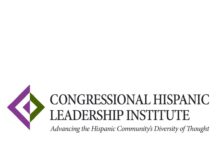WASHINGTON, May 9, 2016 /PRNewswire-HISPANIC PR WIRE/ — Even as the nation reaches an all-time record graduation rate of 82.3 percent, low-graduation-rate high schools – a key focus of the recently passed Every Student Succeeds Act (ESSA) – pose a significant roadblock to the national goal of a 90 percent graduation rate for all students. While the number of low-graduation-rate high schools has declined considerably over the past decade, in some states they still predominate.
Photo – http://photos.prnewswire.com/prnh/20160508/364938
Logo – http://photos.prnewswire.com/prnh/20160508/364937LOGO
Today, Civic Enterprises and the Everyone Graduates Center at the Johns Hopkins University, in partnership with America’s Promise Alliance and the Alliance for Excellent Education, released the 2016 Building a Grad Nation report, the seventh annual update on the progress and challenges in raising high school graduation rates. The four organizations lead the GradNation campaign, a nationwide effort to boost on-time high school graduation rates to 90 percent by the Class of 2020.
This report is the first to analyze 2014 graduation data using new criteria established by ESSA, which defines a low-graduation-rate high school as one that enrolls 100 or more students and has an Adjusted Cohort Graduation Rate (ACGR) of 67 percent or below. States and districts are now required to improve these schools using evidence-based reforms.
New analysis conducted for this report shows that under the ESSA definition, 52 percent of the nation’s low-graduation-rate high schools are charter, virtual and alternative high schools, all of which have grown in number since 2000. Moreover, while collectively charter, virtual and alternative schools account for 14 percent of high schools and 8 percent of students, 20 percent of high school students who do not graduate on time attend these schools. Regular district high schools account for 41 percent of low-graduation-rate high schools and are where the majority of students who do not graduate on time can be found.
There is significant variability in these numbers at the state level. (For state-level data, see Appendix L, ESSA High Schools -100 or more students – with ACGR 67 percent or below, by State and Type, 2014.)
“Many of these schools exist to serve a vulnerable student population, and therefore deal with significant challenges,” said Robert Balfanz, research scientist and co-director of the Everyone Graduates Center at the Johns Hopkins University School of Education. “That’s why it’s so important that educators identify struggling students at the beginning of their high school careers and provide the things all students need to be successful, including the chance to build relationships with caring adults, strong and tailored instruction, and opportunities to engage in learning experiences that connect school to life.”
“We followed the evidence to understand more about low-performing high schools,” said John Bridgeland, president & CEO of Civic Enterprises. “Regardless of the type of school, we must insist upon results and ensure every student receives a high quality education. We need to get beyond labels and get all students what they need to succeed.”
“As the number of low-grad-rate schools grows in some states, it is necessary to take a closer look at when and where these schools are part of the solution or a wrong turn on the path to 90 percent graduation rates for all students,” added Jennifer DePaoli, senior education advisor at Civic Enterprises and the report’s lead author.
The Building a Grad Nation report is based on the most recent comprehensive data from the National Center for Education Statistics at the U.S. Department of Education (2013-14). The 2016 report provides a new national and state-by-state analysis of low-graduation-rate high schools; the number of additional students it will take for the country and each state to reach 90 percent; a look at the validity of graduation rates; and policy recommendations for change.
Here are several of the report’s key findings:
- Low-graduation-rate high schools and key subgroup data. The number of large, low-grad-rate schools (300 or more students) declined from 2,000 in 2002 (enrolling 2.6 million students) to 1,000 in 2014 (enrolling 924,000 students). Including schools of 100 or more students, as ESSA requires, increases the number of low-graduation-rate high schools to 2,397 with a total enrollment of 1.23 million students.
In 41 states, low-income students made up more than 40 percent of the enrollment in low-graduation-rate schools, and in 12 of those states, enrollment of low-income students was greater than 75 percent. In 15 states, Black students made up more than 40 percent of enrollment in schools with a graduation rate of 67 percent or less. In nine states, Hispanic/Latino students made up more than 40 percent of students.
- Low-graduation-rate high schools by school types. Out of all low-grad-rate schools in the nation, 41 percent are regular district schools, 28 percent are alternative schools, 26 percent are charter schools and 7 percent are virtual schools.**
However, when you look within school types at the percentage of low-grad-rate schools, the research shows a different perspective of how these schools are doing.
- Regular district schools (84% of all high schools). Seven percent (7%) of regular district schools, or roughly 1,000 schools nationwide, were low-graduation-rate high schools. Regular district high schools had an average graduation rate of 85 percent. The number of low-graduation-rate regular district high schools across states ranges from zero in Delaware, Hawaii, and Kentucky to more than 276 in New York and 203 in Florida.
- Charter schools (8% of all high schools). Now authorized in all but seven states, the number of charter schools is rising with mixed results on graduation rates. Thirty percent (30%) of charter schools were low-graduation-rate high schools, while 44 percent had high graduation rates of 85 percent and above. Nationwide, charter schools reported an average graduation rate of 70 percent. Hawaii, Arizona, Indiana, Ohio and California have the highest percentages of low-graduation-rate charter high schools.
- Alternative schools (6% of all high schools). Established to meet the needs of “at risk” students, 57 percent of alternative schools are low-graduation-rate high schools. They have an average graduation rate of 52 percent. Sixty percent (60%) of students at alternative high schools are students of color. In 10 states, including Kentucky, Texas, Washington, Idaho and Iowa, 50 percent or more of low-graduation-rate high schools were alternative schools in 2014. Other states have experienced greater success with alternative schools.
- Virtual schools (1% of all high schools). Schools offering all instruction online have greatly increased in recent years. Virtual schools were disaggregated in NCES data for the first time in 2013-14. The data shows that 87 percent of virtual schools are low-grad-rate schools with an average graduation rate of 40 percent. States with the highest percentage of non-graduates coming from virtual schools include Ohio, Idaho, Pennsylvania and Colorado.
The research also takes a closer look at extended year graduation rates and how these calculations may impact the national graduation rate:
- Extended graduation rates. For the first time, researchers were able to examine the impact of additional time on graduation rates. If all states were required to report five-year graduation rates, the national high school grad rate would go up about 3 percentage points. If all states were required to report six-year graduation rates, the rate would go up an additional percentage point.
Policy recommendations. The report recommends, among other findings, that policymakers: 1) Set clear definitions and give graduation rates the weight they deserve in ESSA. 2) Require all states to report extended-year graduation rates (5th or 6th year graduates) in addition to four-year rates to provide a more accurate picture of who is and is not graduating. 3) Create evidence-based plans to improve low-graduation-rate high schools. Without federally determined options for solutions, schools and districts have more flexibility in choosing the best strategies for improvement while still being prompted to set and reach high expectations for their students. 4) Ensure that alternative and virtual schools are included in state accountability and improvement systems.
“ESSA shifts much of the responsibility for student outcomes to states, which must develop robust accountability systems that target large graduation rate gaps that continue to exist between different groups of students, as well as high schools that fail to graduate one-third or more of their students,” said Gov. Bob Wise, president of the Alliance for Excellent Education.
The Road to 90. At 82.3 percent, the national graduation rate is at a new all-time high, but the 2013-14 school year marks the first time in four years that the country is not on track to reach its goal of a 90 percent on-time high school graduation rate by 2020. To stay on track, the national graduation rate must increase by 1.3 percentage points annually. For 2014, the rate went up just .9 percent.
“As the report points out, raising the graduation rate to 90 percent would require graduating an additional 285,000 students,” said John Gomperts, president & CEO of America’s Promise Alliance. “Putting it that way makes the goal appear that much more attainable. But to graduate this additional number of students equitably, the nation will have to focus on getting significantly more low-income students, students of color, students with disabilities, English-language learners and homeless youth on track to earning a diploma. Persistence is key.”
Authors and sponsors. The 2016 Building a Grad Nation: Progress and Challenge Raising High School Graduation Rates report is co-authored by Jennifer DePaoli and John Bridgeland of Civic Enterprises and Robert Balfanz and his team at the Everyone Graduates Center at the Johns Hopkins University School of Education. The 2016 report is presented by lead sponsor AT&T, with supporting sponsorship from Target and State Farm.
Full report. To read the full report, access graphics, state-by-state data and other resources, visit: www.GradNation.org/2016report.
Webinar. To learn more, register for the Building a Grad Nation webinar on Mon, May 9, 2016 at 3 PM ET. The researchers will discuss their findings and analysis.
**According to NCES definitions, there is inherent overlap between the alternative, charter, and virtual school categories, so these numbers do not add up to 100 percent. When looking just at district-operated alternative schools, they make up 23 percent of low-graduation-rate high schools, and when separating virtual schools out from charter schools, the percentage of low-graduation-rate schools that are charter schools falls to 22 percent. In addition, vocational and special education schools were omitted from the count but can be found in the appendix of the report.
Civic Enterprises is a public policy and strategy firm that helps corporations, nonprofits, foundations, universities and governments develop and spearhead innovative public policies to strengthen our communities and country. Created to enlist the private, public and nonprofit sectors to help address our nation’s toughest problems, Civic Enterprises fashions new initiatives and strategies that achieve measurable results in the fields of education, civic engagement, economic mobility, and many other domestic policy issues. www.civicenterprises.net
The Everyone Graduates Center at the Center for Social Organization of Schools at the School of Education at Johns Hopkins University seeks to identify the barriers to high school graduation, develop strategic solutions to overcoming these barriers and build local capacity to implement and sustain the solutions so that all students graduate prepared for adult success. www.every1graduates.org
America’s Promise Alliance leads the nation’s largest network dedicated to improving the lives of children and youth. As its signature effort, the GradNation campaign mobilizes Americans to increase the on-time high school graduation rate to 90 percent by the Class of 2020 and prepare young people for postsecondary enrollment and the 21st century workforce. www.AmericasPromise.org
The Alliance for Excellent Education is a Washington, DC-based national policy and advocacy organization dedicated to ensuring that all students, particularly those who are traditionally underserved, graduate from high school ready for success in college, work, and citizenship. www.all4ed.org
MEDIA CONTACTS:
Daria L. Hall
America’s Promise Alliance
202.657.0621/718.404.7448
[email protected]
Kathleen McMahon
Civic Enterprises
703-868-6981
[email protected]
Mary Maushard
Everyone Graduates Center
410.516.8810
[email protected]
Jason Amos
Alliance for Excellent Education
202.828.0828
[email protected]
Available Topic Expert: John Gomperts
For information on the listed expert, click appropriate link.
ProfNet – https://profnet.prnewswire.com/Subscriber/ExpertProfile.aspx?ei=120616






